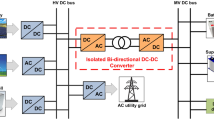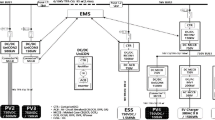Abstract
In this article, a fifteen-level cascaded H-bridge multilevel inverter with active power filtering capability is suggested to increase the power quality in a single-phase distributed generation (DG) system. Integrating renewable power sources in the distribution line becomes easier with advancements in power electronic converters. At the same time, increase in usage of nonlinear loads leads to electronic pollutions like harmonics and power factor issues. Since most of the DG systems have interfacing inverters, it can be utilized for power quality improvement. This proposed work presents a control scheme to gain maximum utilization of these grid interfacing inverters with artificial neural network (ANN). An instantaneous p-q theory in a-ß-0 reference frame-based control algorithm is derived to control the inverter in the single-phase distribution system. In the ANN-based approach, the control algorithm is solved and the ANN is trained based on the switching angles obtained. The trained system is integrated with DG system to operate as a multitasking circuit by adding active power filter (APF) operation. It is proposed to utilize the interfacing inverter as: (1) interfacing inverter to add power produced from renewable sources and (2) APF to mitigate the harmonics. Both functions are accomplished simultaneously. The proposed work is verified with extensive MATLAB/Simulink, and the obtained results demonstrate that the proposed approach delivers a notable improvement in power quality concerning reduction in total harmonic distortion and injection of real power generated through RES into the distribution line. A 3-kWp photovoltaic panel with multifunctioning inverter designed utilizing ANN is executed in an experimental setup to prove the efficiency of the proposed approach.









Similar content being viewed by others
References
Agarwal RK, Hussain I, Singh B (2018) Application of LMS-based NN structure for power quality enhancement in a distribution network under abnormal conditions. IEEE Trans Neural Netw Learn Syst 29(5):1598–1607
Angulo M, Lago J, Ruiz-Caballero D, Mussa S, Heldwein M (2013) Active power filter control strategy with implicit closed loop current control and resonant controller. IEEE Trans Ind Electron 6(7):2721–2730
Arrillaga J, Watson NR (2003) Power system harmonics, 2nd edn. Wiley, Amsterdam, pp 60–142
Belaidi R, Haddouche A et al (2011) Improvement of the electrical energy quality using a Shunt Active Filter supplied by a photovoltaic generator. Energy Procedia 6:522–530
Bhattacharya A, Chakraborty C (2011) A shunt active power filter with enhanced performance using ANN-based predictive and adaptive controllers. IEEE Trans Ind Electron 58(2):421–428
Chandra A, Singh B, Singh BN, Al-Haddad K (2000) An improved control algorithm of shunt active filter for voltage regulation, harmonic elimination, power-factor correction, and balancing of nonlinear loads. IEEE Trans Power Electron 15(3):495–507
Chang GW, Shee T-C (2004) A novel reference compensation current strategy for shunt active power filter control. IEEE Trans Power Deliv 19(4):1751–1758
Chilipi RR, Al-sayari N, Beig AR, Al-hosani K (2016) A multitasking control algorithm for grid-connected inverters in distributed generation applications using adaptive noise cancellation filters. IEEE Trans Energy Convers 31(2):714–727
Cirrincione M, Pucci M, Vitale G (2008) A single-phase DG generation unit with shunt active power filter capability by adaptive neural filtering. IEEE Trans Ind Electron 55(5):2093
Haddad RJ, Guha B, Kalaani Y, El-Shahat A (2018) Smart distributed generation systems using artificial neural network-based event classification. IEEE Power Energy Technol Syst J 5(2):18–26
Kanjiya P, Khadkikar V, Zeineldin HH (2013) A non iterative optimized algorithm for shunt active power filter under distorted and unbalanced supply voltages. IEEE Trans Ind Electron 60(12):5376–5390
Kinhal VG, Agarwal P, Gupta HO (2011) Performance investigation of neural-network-based unified power-quality conditioner. IEEE Trans Power Deliv 26(1):431–437
Liang X (2017) Emerging power quality challenges due to integration of renewable energy sources. IEEE Trans Ind Appl 53(2):855
Martinez-Rodriguez PR et al (2017) Analysis and experimental validation of a controller for a single-phase active power filter based on a 3L-NPC topology. Int Trans Electr Energy Syst 27(11):e2385
Montero MIM, Cadaval ER, Gonzalez FB (2007) Comparison of control strategies for shunt active power filters in three-phase four-wire systems. IEEE Trans Power Electron 22(1):229–236
Mortezaei A, Simoes MG (2018) Grid-connected symmetrical cascaded multilevel converter for power quality improvement. IEEE Trans Ind Appl 54(3):2792
Prasad KK, Myneni H, Siva Kumar G (2018) Power quality improvement and PV power injection by DSTATCOM with variable DC link voltage control from RSC-MLC. IEEE Trans Sustain Energy 10(2):876–885
Qasim M, Khadkikar V (2014) Application of artificial neural networks for shunt active power filter control. IEEE Trans Ind Inf 10(3):1765–1774
Rodriguez J, Lai J-S, Peng FZ (2002) Multilevel inverters: a survey of topologies, controls, and applications. IEEE Trans Ind Electron 49(4):724–738
Rudnick H, Dixon J, Moran L (2003) Delivering clean and pure power. IEEE Power Energy Mag 1(5):32–40
Shirajum M, Yun M, Li W (2013) Residential distribution system harmonic compensation using PV interfacing inverter. IEEE Trans Smart Grid 4(2):816–827
Singh M, Khadkikar V, Chandra A, Varma RK (2011a) Grid interconnection of renewable energy sources at the distribution level with power-quality improvement features. IEEE Trans Power Deliv 26(1):307–315
Stonier AA, Lehman B (2018) An intelligent-based fault-tolerant system for solar-fed cascaded multilevel inverters. IEEE Trans Energy Convers 33(3):1047–1057
Stonier AA (2017) Design and development of high performance solar photovoltaic inverter with advanced modulation techniques to improve power quality. Int J Electron 104(2):174–189
Tang Y, Loh PC, Wang P, Choo FH, Gao F, Blaabjerg F (2012a) Generalized design of high performance shunt active power filter with output LCL filter. IEEE Trans Ind Electron 59(3):1443–1452
Tang X, Tsang KM, Chan WL (2012b) A power quality compensator with DG interface capability using repetitive control. IEEE Trans Energy Conv 27(2):213–219
Tareen WU, Mekhilef S, Seyedmahmoudian M, Horan B (2017) Active power filter (APF) for mitigation of power quality issues in grid integration of wind and photovoltaic energy conversion system. Renew Sustain Energy Rev 70:635–655
Valdez-Fernández AA, Martínez-Rodríguez PR et al (2013) A model-based controller for the cascade h-bridge multilevel converter used as a shunt active filter. IEEE Trans Ind Electron 60(11):5018–5028
Acknowledgements
The authors acknowledge University Grants Commission (Government of India) for providing financial assistance for the project titled “Design and Development of Hybrid Renewable Energy System Using Multilevel Inverters for Power Quality Improvement” (Ref. No. 30-1/2013 (SA-II)/RA-2012-14-GE-TAM-2559) under Research Award Scheme.
Author information
Authors and Affiliations
Corresponding author
Ethics declarations
Conflict of interest
The authors declare that they have no conflict of interest.
Ethical approval
This article does not contain any studies with human participants or animals performed by any of the authors.
Additional information
Communicated by V. Loia.
Publisher's Note
Springer Nature remains neutral with regard to jurisdictional claims in published maps and institutional affiliations.
Rights and permissions
About this article
Cite this article
Rajkumar, R., Ragupathy, U.S. An ANN-based harmonic mitigation and power injection technique for solar-fed distributed generation system. Soft Comput 24, 15763–15772 (2020). https://doi.org/10.1007/s00500-020-04907-7
Published:
Issue Date:
DOI: https://doi.org/10.1007/s00500-020-04907-7




